Samsung Epic 4G Review: The Fastest Android Phone
by Anand Lal Shimpi on September 6, 2010 5:28 PM EST- Posted in
- Smartphones
- Samsung
- Epic 4G
- Gadgets
- Mobile
Easily Influenced
As the manufacturer for both the NAND that goes into Apple devices and the SoC that Apple uses in the iPhone/iPad, Samsung works closer with Apple than most other smartphone vendors. I was once given a characterization of Samsung that I will never forget: this is a company that’s trying to learn as much as it can from Apple for use in its own smartphone endeavors.
There’s no better example than the Galaxy S. Unlike other vendors who have been Cupertino inspired, Samsung’s learnings are put to use almost exclusively in software. Physically, the Galaxy S is quite dissimilar from the industrial design used in Apple’s iOS products.
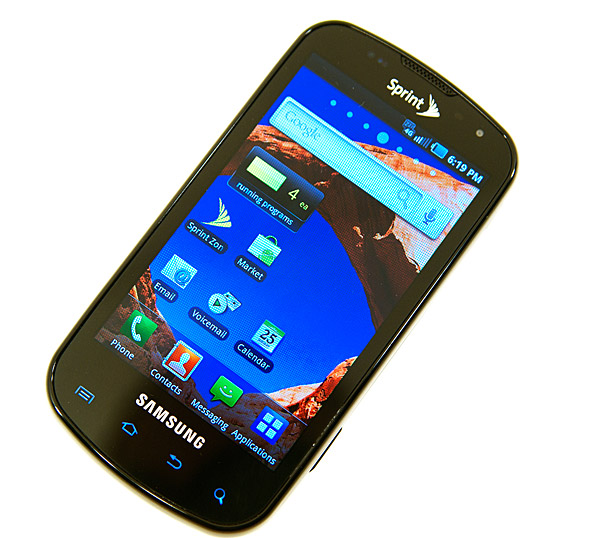
Samsung sent me the Epic 4G, a variant of the Galaxy S for use on Sprint’s network (with WiMAX support as implied by the 4G moniker). The Epic 4G has an amazingly contrasty 4” 800 x 480 Super AMOLED display. The capacitive touchscreen is backed up by a physical keyboard that slides out in landscape mode.
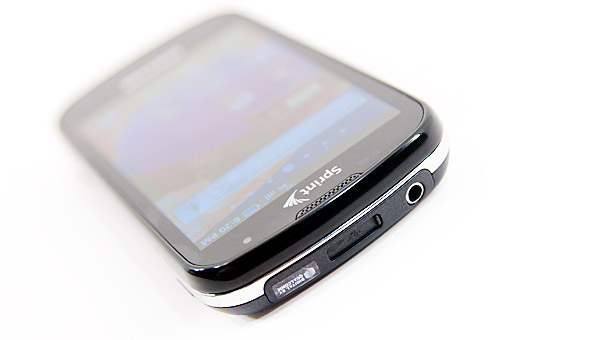
I’d say that Samsung did everything to be the most unlike Apple in the design of the Epic 4G. Along the top you have a microUSB port, but Samsung included a sliding cover to keep the pocket lint out. This adds complexity to the look of the device, but is nicely protective if you’re a bit OCD about getting lint in the crevices of your phone. The sheer location of the microUSB port is unusual as well. Most Android phones we’ve looked at have their power/sync connector at the bottom of the phone, not the top.
The power/lock button also shifts positions compared to what we’re used to. It’s on the right side, near the top on the Epic 4G.
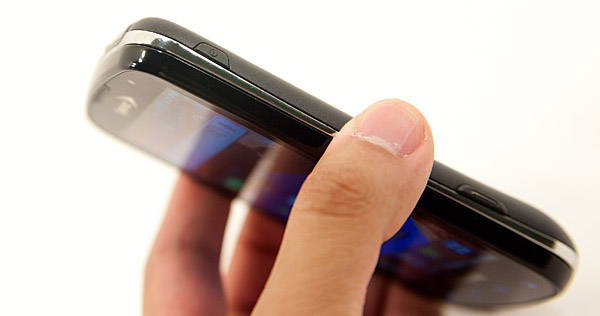
On the lower part of the right side of the phone there’s a shutter release button for the camera. There’s a volume rocker on the left side of the phone. All of the buttons on the Epic 4G have a rubbery texture to them with the exception of the shutter release button which has a metal insert surrounded by rubber.
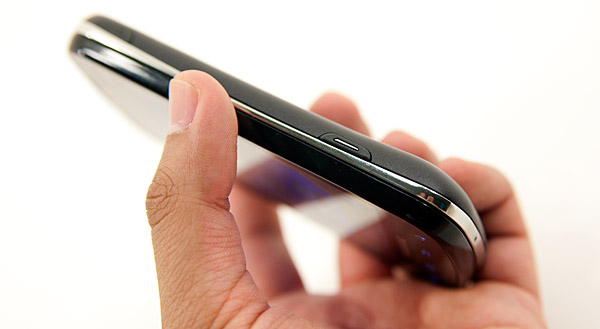
The screen slides up to reveal a landscape keyboard on the Epic 4G. The sliding mechanism is easy enough to operate with one hand and reasonably smooth. It’s not the most confidence inspiring but not terrible either.
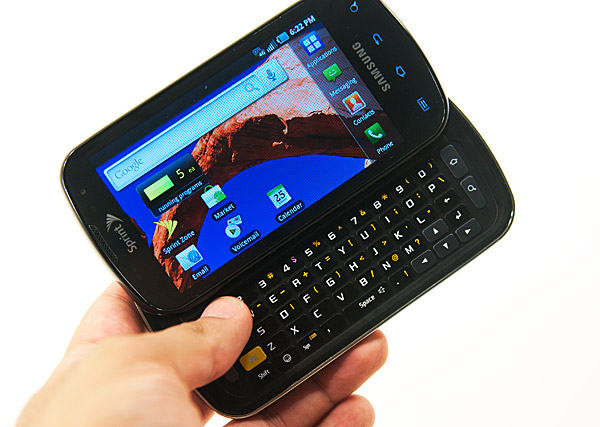
The physical keyboard itself is a nice addition for those who must absolutely have it. Samsung even duplicates the four Android keys on the keyboard itself (home, back, menu, and search) so you can exclusively use the physical keyboard for navigating the OS if you’d like. There is no scroll ball or equivalent on the Epic 4G, but the physical keyboard does have four arrow keys you can use in its stead.
The keys on the physical keyboard are fairly wide and reasonably spaced (it is a landscape keyboard after all). The keys are missing some curved definition that would make it easier to touch type on them but overall it’s not a bad keyboard. Again, not the best I’ve encountered but not terrible at all.
Since this is a slider phone, build quality isn’t the easiest to guarantee. The two halves of the phone independently feel well made, but the joining of the two isn’t super secure. The “oreo effect” as Brian likes to call it is very present on the Epic 4G. You can twist the top and bottom halves of the phone and get them to separate by a couple of degrees. It’s not terrible but if having a loose feeling phone bothers you then you may want to look elsewhere.

The four standard Android keys are also present in capacitive touch form along the bottom edge of the Epic 4G. Unlike most other Android phones, the capacitive buttons aren’t visibly outlined on the phone. You can only see them if they’re backlit, which has a timer associated with it that’s by default separate from the screen timer. What this means is that the row of Android buttons will actually disappear before the screen goes blank if you don’t touch the phone. Thankfully Samsung provides a setting to sync these two so both the screen and buttons go blank at the same time, but it’s just not enabled by default.
The Epic 4G is a good fit in my hand, but with a physical keyboard it is a thicker phone than most I’m used to. If you’re coming from a standard cellphone or feature phone, the Epic 4G is going to feel huge - if you’re coming from another Android/iOS device, it won’t be too bad.

From left to right: Google Nexus One, Samsung Epic 4G, iPhone 4
The phone is a mixture of materials, with the front being glossy plastic, then a chrome strip around the middle and a matte black back cover.
The back cover snaps off with relative ease revealing the 1500mAh battery, a microSD card slot and what looks like four external antenna connectors. I’m not really sure what the exposed connectors are for, perhaps to help during hardware testing/debug. Not having to take the battery out to get to the microSD card is a nice addition as well. The phone comes with a 16GB card as well as a microSD to SD card adapter for use in standard card readers.

Finally on the back we have a lens for the 5MP camera sensor and a single LED flash.
| Physical Comparison | |||||||||
| Apple iPhone 4 | Apple iPhone 3GS | Samsung Epic 4G | HTC EVO 4G | Motorola Droid X | |||||
| Height | 115.2 mm (4.5") | 115 mm (4.5") | 124 mm (4.9") | 121.9 mm (4.8") | 127.5 mm (5.02") | ||||
| Width | 58.6 mm (2.31") | 62.1 mm (2.44") | 63.5 mm (2.5") | 66.0 mm (2.6") | 66.5 mm (2.62") | ||||
| Depth | 9.3 mm ( 0.37") | 12.3 mm (0.48") | 15.2 mm (0.6") | 12.7 mm (0.5") | 9.9 mm (0.39") | ||||
| Weight | 137 g (4.8 oz) | 133 g (4.7 oz) | (5.47 oz) | 170 g (6.0 oz) | 155 g (5.47 oz) | ||||
| CPU | Apple A4 @ ~800MHz | Apple/Samsung A3 @ 600MHz | Samsung Hummingbird @ 1GHz | Qualcomm Scorpion @ 1GHz | TI OMAP 3630 @ 1GHz | ||||
| GPU | PowerVR SGX 535 | PowerVR SGX 535 | PowerVR SGX 540 | Adreno 200 | PowerVR SGX 530 | ||||
| RAM | 512MB LPDDR1 (?) | 256MB LPDDR1 | 512 MB LPDDR1 | 512MB LPDDR1 | 512MB LPDDR1 | ||||
| NAND | 16GB or 32GB integrated | 16 or 32GB integrated | 1 GB integrated, 16 GB microSD preinstalled | 1 GB integrated, 8 GB microSD preinstalled | 8 GB integrated, preinstalled 16 GB microSD | ||||
| Camera | 5MP with LED Flash + Front Facing Camera | 3MP with autofocus | 5 MP with LED Flash and autofocus | 8MP with dual LED Flash + Front Facing Camera | 8MP with dual LED Flash | ||||
| Screen | 3.5" 640 x 960 LED backlit LCD | 3.5" 320 x 480 | 4.0" 480 x 800 | 4.3" 480 x 800 | 4.3" 480 x 854 | ||||
| Battery | Integrated 5.254Whr | Integrated 4.51Whr | Removable 5.55Whr | Removable 5.5Whr | Removable 5.698 Whr | ||||










93 Comments
View All Comments
medi01 - Tuesday, September 7, 2010 - link
Java's JIT could create code that is faster than C/C++. Because unlike C++ compiler, it also has runtime info about executables, it could know for sure, which of the if branches is more likely to be true, for instance.The only part of Java that was much slower than C++ was (and I think still is) sin/cos related functions. Since Sun had to guarantee "runs anywhere" with the exactly the same results, instead of using CPU's features they "manually" calculate it.
Voo - Tuesday, September 7, 2010 - link
Well java WAS slow - around ten years ago, but people have already made up their mind, it's hard to get new ideas into some heads. Though the lack of a JIT in dalvik hampered performance, but that's hardly something where you can blame the language for..Ah, just like all those people who still believe that manual memory managment is inherently faster than GC..
medi01 - Tuesday, September 7, 2010 - link
Java is not inherently slower than C++, but it does need more memory.The problem with Androids up to 2.2 was Dalvik VM that had no JIT.
designerfx - Tuesday, September 7, 2010 - link
what a brilliant troll, or accidental. I'm not sure, but plenty of debunked this.What really brings down the entire samsung line of phones is that the GPS is horrible. I have one myself, and have the same issue on the vibrant as on the epic. Samsung really screwed the GPS up bigtime.
lwatcdr - Tuesday, September 7, 2010 - link
Well when faced with such a brilliant technical argument like "but Java sucks. Big time" what can one say.http://www.cnn.com/2004/TECH/space/01/16/space.mar...
Is an article from back in 2004 about how those idiots at NASA used Java to control the Spirit rover on Mars.
If only they had you available to show them how to do right.
Man I get sick of this crap. I heard the same thing way back when. People complaining when programmers used high level languages to write programs instead of assembly.
The thing is that it was all silliness just as it is now.
What really counts isn't the language but the programmer using it.
Android's speed issues tend to because by.
1. Not using the GPU for the UI
2. Using multitasking from the start.
IOS has only just now gotten official multitasking and even that is limited.
But really just drop the
Iksy - Tuesday, September 7, 2010 - link
Umm... to be clear, this is just the user interface used on Earth, which is something Java does well. The rovers themseves are controlled using VxWorks RTOS. VxWorks itself is written in C or C++ I believe.Ethaniel - Tuesday, September 7, 2010 - link
Well, it's not the kind of technical argument everyone would like, but it gets to the point. Anand reviewed like half a dozen of Android phones, all with the same problem. So, or the companies are making exactly the same mistake with each and every model they launch, or Java is to blame. And no, I'm not trolling because I do want to Android to succeed. A troll is based on hate, and it usually doesn't check back the thread he/she started. And you haven't seen a single insult in this thread, right? ;)ktwebb - Monday, September 6, 2010 - link
Sounds like an IPhone Fanboy that is trying his best to be subjective. Samsung actually did not get it right performance wise. They use an antiquated and slow file system. For a pleasurable UI experience on Android, the N1 is still king, especially on 2.2. The only way the samsung galaxy variants fly is with root access and ext2, 3 or 4 fixes. there are GPS fixes as well however where Samsung let down actually is in the UI with Touchwiz and their ridiculous homage to Apple. No wonder this twit liked it. Android people IMMEDIATELY change the launcher. Anyway, the Hardware on the Galaxy S is excellent. Samsung did their best to eff it up and only with tweaks and root level access is it a really strong phone. Google and Androids main problem is OS sprawl and fragmentation. They get that cleaned up and the IPhone 4 is a distant second mobile OS. Right now, with the clear advantages Android phones have, specifically customization and an open source community among others, it's essentially a wash. It's about what you prefer and are comfortable with. I'm an Android guy because I like to make my phone do what I want it to, not what Jobs wants my phone to be.StealthX32 - Monday, September 6, 2010 - link
ktwebb, I don't think Anand reviewed it w/ the ext2 FS hack/fix (whatever you want to call it). The UI speed is fine from the factory; it's much better than the EVO 4G (even with Froyo) and on par w/ the N1, just not as good as it *could* be once you root it and fix the filesystem.ktwebb - Tuesday, September 7, 2010 - link
N1 Froyo is faster than stock Galaxy S Variants. And yeah, he didn't review with hacks and I certainly understand why he wouldn't. Shouldn't need them. But that is a Samsung issue, not Android. Samsung has the potential for a very good handset with the Galaxy S. They are trying their best to eff it up though. I haven't played with the EVO but had android phones since the G1 inception. The N1 was the best UI experience after Froyo was pushed. And far better than any IPHone I've used, although my experience with 4 is limited.